While we are already talking about that critter: Has anybody ever tested one on a smaller horn for usage above around 800 Hz ? This driver is probably also interesting for usage in a four-way system.
Regards
Charles
Regards
Charles
We stock ≈3:1 more 8Ω than 16Ω in the USA, probably the same everywhere. Personally I prefer the 16Ω as it has a bit less coil mass, but we're shaving dB here. Use whichever you can get in the time frame you need!I am just about to pull the trigger and buy a pair. Which impedance should I choose? 8 ohms, 16 ohms - which one is more common? Or does it matter at all?
The 4599ND has two most outstanding features:
It is the loudest audio transducer ever made
The frequency range is optimized for human voice
These capabilities make it best suited for:
Communication devices for long distance
Security systems
Emergency devices
Mass notification systems
Systems for scattering birds from airports
Marine applications
Military and police communication system
Noise cancelation systems
High End Audio Loudspeakers
If you compare it to the BMS4592ND-mid-8 on the same horn it has more output, ~-6dB harmonic distortion and a smoother frequency response. I guess the only disadvantage if you wanted a dedicated mid-range driver is the cost!
http://www.bmsspeakers.com/fileadmin/bms-data/product_data_2012/bms_4592-mid_t_data_2012-01.pdf
http://www.bmsspeakers.com/fileadmin/bms-data/product_data_2014/bms_4599nd_preliminary.pdf
I wonder how these drivers (coaxial and dedicated midrange 2" throat) compare to the midrange specific drivers from community that had a 4" throat?
FYI Joseph Crowe just posted a blog entry for the BMS 4599 driver. I was looking at this driver for a midrange horn but now I have second thoughts.
Bottom line: Troy thinks the bms is unsuitable for home audio mainly due to high IM distortion. (+ is rather pricy to me)
The other one mentioned above is the 4592 which supposedly has even higher distortion than the 4599. Yet, I read favorable comparisons of the 4592 to the axi2050 and calls it indistinguishable from the TAD td-4002 is sound! That only adds to my confusion.😒
AudioXpress say it's available now: https://audioxpress.com/news/b-c-sp...ange-coaxial-ring-radiator-compression-driver
YouTube video here:
YouTube video here:
In the datasheet the response of the DCX354 looks a little wobbly. But that may be due to the horn they used. There are not a lot of details on the horn useed. They are just talking of an exponential horn with a 320 Hz cutoff. Maybe it is their ME464. But personally I wouldn't call that one an exponential horn either ....
But the fact that it uses a lower compression ratio might make it interesting for power HiFi applications. I wonder what the path difference between the HF part and the mid part is.
Regards
Charles
But the fact that it uses a lower compression ratio might make it interesting for power HiFi applications. I wonder what the path difference between the HF part and the mid part is.
Regards
Charles
An event service provider from my vicinity is currently looking at potentially building a system with the DCX464(-16) on ME464. As acoustic measurements are one of my main areas of expertise & my measurement setup is high level independently verified (vs. Klippel NFS, vs. specialist journal Production Partner, etc. - ref.: ARTA Ringversuch #3), I was asked to evaluate the combination.
Environment / setup was free field, 4pi (-> speaker & mic on stand), 4m distance, 2m height.
Program was:
If not for time constraints, the program would have been yet a bit more extensive. Another measurement session might take place sometime in the foreseeable future, depending on the owner's conclusions & plans.
For now, if anybody is interested, I will say that our harmonic distortion numbers correlated decently with those seen on page 13 of this thread. Different horn, different filtering, different measurement setup / environment / variables, so per definition the results cannot be the same - but let's say they're in the same ballpark.
Environment / setup was free field, 4pi (-> speaker & mic on stand), 4m distance, 2m height.
Program was:
- mid section unfiltered FR / sensitivity measurement @ 4 Vrms = 1 watt @ 16 ohms
- high section unfiltered FR / sensitivity measurement @ 4 Vrms = 1 watt @ 16 ohms
- combined (active XO), but unfiltered (FR not flattened) FR & harmonic distortion at up to 12,65 Vrms = 10 watts (~125 dB @ 1m)
- combined (active XO), but unfiltered (FR not flattened) multitone distortion (IMD & HD) at RMS SPLs of 90, 100 and 110 dB (102, 112 and 122 @ 1m)
- rudimentary listening tests at the aforementioned levels / SPLs
If not for time constraints, the program would have been yet a bit more extensive. Another measurement session might take place sometime in the foreseeable future, depending on the owner's conclusions & plans.
For now, if anybody is interested, I will say that our harmonic distortion numbers correlated decently with those seen on page 13 of this thread. Different horn, different filtering, different measurement setup / environment / variables, so per definition the results cannot be the same - but let's say they're in the same ballpark.
The polar response I got with DCX464 on a cheap taobao horn.
The shape is very similar to RCF HF94 horn and I believe it's a clone to it.
Measured with on axis EQ
The angle might not be very precise since I'm spinning the horn, not the microphone

The shape is very similar to RCF HF94 horn and I believe it's a clone to it.
Measured with on axis EQ
The angle might not be very precise since I'm spinning the horn, not the microphone
New to this thread -
I didn't even know that this level of (dB) sensitivity/efficiency was even possible. (without a horn)
I find it quite astonishing.
I didn't even know that this level of (dB) sensitivity/efficiency was even possible. (without a horn)
I find it quite astonishing.
An event service provider from my vicinity is currently looking at potentially building a system with the DCX464(-16) on ME464. As acoustic measurements are one of my main areas of expertise & my measurement setup is high level independently verified (vs. Klippel NFS, vs. specialist journal Production Partner, etc. - ref.: ARTA Ringversuch #3), I was asked to evaluate the combination.
Environment / setup was free field, 4pi (-> speaker & mic on stand), 4m distance, 2m height.
... Another measurement session might take place sometime in the foreseeable future, depending on the owner's conclusions & plans. ...
Update: the owner has put the project on ice due to personal reasons, so a more extensive review might never happen. So I'll publish what I got so far.
Mid (green) & high frequency (black) section unfiltered FR / sensitivity measurement @ 4 Vrms = 1 watt @ 16 ohm; SPL scaled to 1m distance; gated, unsmoothed:
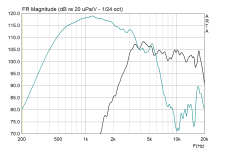
Mid frequency (left) & high frequency (right) section Burst Decay:
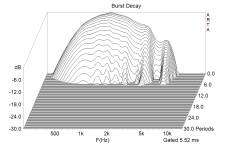
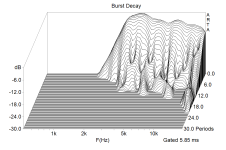
Mid frequency section unfiltered FR & harmonic distortion @ 4 Vrms; scaled to 1m; ungated (ARTA can't gate distortion measurements), 1/3 oct smoothed to flatten out the floor reflexion:
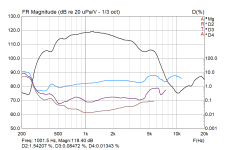
High frequency section unfiltered FR & harmonic distortion @ 4 Vrms; scaled to 1m; ungated, smoothed:
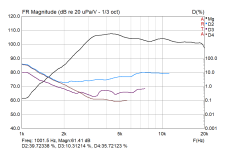
Combined mid & high frequency FR & harmonic distortion (with quick & dirty active XO; no further filtering / EQing) @ 12,65 Vrms = 10 watts @ 16 ohms; scaled to 1m; ungated, smoothed:
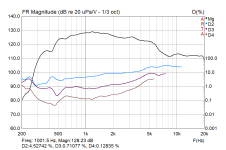
Combined mid & high frequency multitone distortion measurements with EIA-426B output filter at RMS SPLs of left to right 90, 100 and 110 dB (102, 112 and 122 @ 1m); note, environmental noise below ~300 Hz:
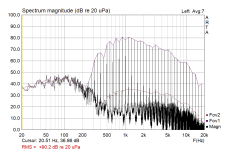
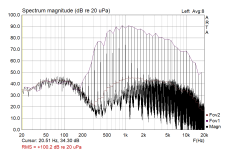
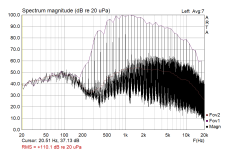
Hope the data proved to be interesting / helpful.
For the 10W HD measurement, and the multitone distortion tests, it was a symmetric LR24 XO in DSP at I don't remember which frequency - probably around 4 kHz? No gain adjustment, no linearization, just a quick & dirty XO to be able to measure the unit as a whole.
The owner planned to use B&C's passive XO in his final project, but as I said he'll probably abandon it.
The owner planned to use B&C's passive XO in his final project, but as I said he'll probably abandon it.
I figured that's where you headed. Yeah, I'd like to do the whole compression / M-Noise routine, but i can only get away with so much in the neighborhood...especially given that my testing is off a deck pointed out over a large lake ...and carries forever and then some.
Anyway, I'd did get to make a bunch of sweeps of both drivers just now, tuned for flat SPL.
I stopped at 132dB to give folks a break.
SPL is accurate from 1m. Actual distance was 8ft. Same xti1464 again.
First is the dcx464; second the bms4595he
dcx 500Hz and 3.2kHz xovers; bms 500Hz and 6.3kHz
Thanks for the data Mark!
... I'll publish what I got so far.
Jesus Christ.. I shouldn't refer to my measurement accuracies when I obviously can't be bothered to load the proper microphone calibration for a given set of measurements. I was already asking myself why the HF section was so quiet, then discovered I had the calibration file of my old ECM-40 loaded.. about 10 dB difference up top to my current EMX-7150.
Here's the correct 4 Vrms = 1w FR unfiltered measurement (scaled to 1m 4pi):
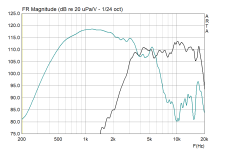
And the 12,65 Vrms = 10w FR & harmonic distortion measurement with XO:
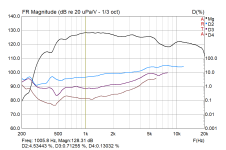
The multitone distortion measurements are unaffected, since those were originally exported with the right calibration file loaded; and the Burst Decay data is also essentially unaffected.
Sorry for any confusion. Again, I now hope the correct data will prove useful.
Can you post a picture of the actual speaker system the 464 is being used in .464 crossover
Hello guys! I sent the 464 to Joseph Crow and he designed a crossover with his 300hz horns. I must say he did a great job! worth every penny. I did end up with a huge crossover compared to the 'OEM' FB464! To A/B them is not fair because the filters that Joseph put in flattened out the response so much so that my DSP (MiniDSP) had little work to do. Good job Joseph. I am now using some Mundorf Supremes and better in the FB464 configuration and see if the DSP can 'fix' the stock crossover. Then A/B it. Its all about 'fun'!!
Thanks
I hope this discussion continues, it's very informative but I don't think I'm yet to see "THE" straightforward singular answer to how best to use these for a low spl hifi home environment (what horn, what crossover), and I'm most interested in the comparison between the dcx464 and dcx 354, because it seems like the smaller one would be better for that application.
I'm trying to build a "2-way" (3 way if u consider the coax) with probably a higher end b&c pro 15" tuned low to try and get as close to full range as possible. MiniDSP Flex HT or the likes will be used for XO and PEQ duty / delay to time allign.
These drivers seem like they could be a great option compared to trying to find the best 1.4" CD that can best cover ~800hz to 20khz. But given that the SPL needs are low for a driver like this (though I will certainly boost the low bass to taste and come close to using the maximum output of any 15s I buy, since I will run pure 2ch with no sub), I'm wondering what option would truly be best from a sound quality perspective, if I don't necessarily care about crossing at 400hz or 800hz. I do like the idea of a point source crossed as low as possible though, in theory, but not if it's at the expense of audible distortion - but at 90db it doesn't seem like distortion should be an issue, though I wonder about the effects of the ME464 horn geometry and diffraction.
Suggestions highly welcome, and DCX354 input especially welcome, along with best SQ horn choice (with relatively wide horizontal dispersion), best XO point for the coax for SQ, and even 15" driver suggestions given the goal of strong sub 30hz output (with EQ obv.)
I'm trying to build a "2-way" (3 way if u consider the coax) with probably a higher end b&c pro 15" tuned low to try and get as close to full range as possible. MiniDSP Flex HT or the likes will be used for XO and PEQ duty / delay to time allign.
These drivers seem like they could be a great option compared to trying to find the best 1.4" CD that can best cover ~800hz to 20khz. But given that the SPL needs are low for a driver like this (though I will certainly boost the low bass to taste and come close to using the maximum output of any 15s I buy, since I will run pure 2ch with no sub), I'm wondering what option would truly be best from a sound quality perspective, if I don't necessarily care about crossing at 400hz or 800hz. I do like the idea of a point source crossed as low as possible though, in theory, but not if it's at the expense of audible distortion - but at 90db it doesn't seem like distortion should be an issue, though I wonder about the effects of the ME464 horn geometry and diffraction.
Suggestions highly welcome, and DCX354 input especially welcome, along with best SQ horn choice (with relatively wide horizontal dispersion), best XO point for the coax for SQ, and even 15" driver suggestions given the goal of strong sub 30hz output (with EQ obv.)
Have you thought of the Faital HF1440? It has more than enough output for a domestic application and removes the need for more amplifiers.
I have absolutely considered that exact driver, yes. Do you have experience with it? I would bi-amp and DSP it either way, coax or not. Given a relatively low SPL home use case, if I want to achieve say at least 90-100db before distortion significantly rises, and I could use a 4th order slope, how low can the HF1440 be crossed and sound good? B&C says 700hz at 12db/oct, which already sounds pretty great for my use case, but if you know of a frequency and slope that sounds better lmk. And perhaps more importantly, what horn(s) do you recommend, both to match decently well with the 15", and/or with the goal of relatively wide dispersion with vertical dispersion not being a significant consideration as long as it's not too too beamy. Sound quality is the main factor, but there's so many choices.
SEOS 18, 22, 24...
Ciare PR614 https://www.usspeaker.com/ciare pr614-1.htm
Faital LTH142 https://www.usspeaker.com/Faital Pro LTH142-1.htm
B&C ME145 / ME90
RCF HF94 / HF 96 / HF950
Beyma TD385
Eminence H14EA
LaVoce HD1403
And more I'm probably missing. But based on some threads on the HF1440, being a ring radiator, some find the sound inferior to domes, calling it "flat", and don't like to push the lower limits of frequency response, and talk about it's resonant behavior. I'm also open to beryllium drivers from Radian, if they're indeed considered well-rounded end game options, for hitting 800hz or less and stretching to 20k. Faital also seems to have other interesting options, HF144, HF14AT/HF10AT (1"), and then there's the TexTreme Eminence model(s), and many others. Why do you point to the HF1440 specifically?
Thanks.
SEOS 18, 22, 24...
Ciare PR614 https://www.usspeaker.com/ciare pr614-1.htm
Faital LTH142 https://www.usspeaker.com/Faital Pro LTH142-1.htm
B&C ME145 / ME90
RCF HF94 / HF 96 / HF950
Beyma TD385
Eminence H14EA
LaVoce HD1403
And more I'm probably missing. But based on some threads on the HF1440, being a ring radiator, some find the sound inferior to domes, calling it "flat", and don't like to push the lower limits of frequency response, and talk about it's resonant behavior. I'm also open to beryllium drivers from Radian, if they're indeed considered well-rounded end game options, for hitting 800hz or less and stretching to 20k. Faital also seems to have other interesting options, HF144, HF14AT/HF10AT (1"), and then there's the TexTreme Eminence model(s), and many others. Why do you point to the HF1440 specifically?
Thanks.
Last edited:
- Home
- Loudspeakers
- Multi-Way
- B&C DCX464